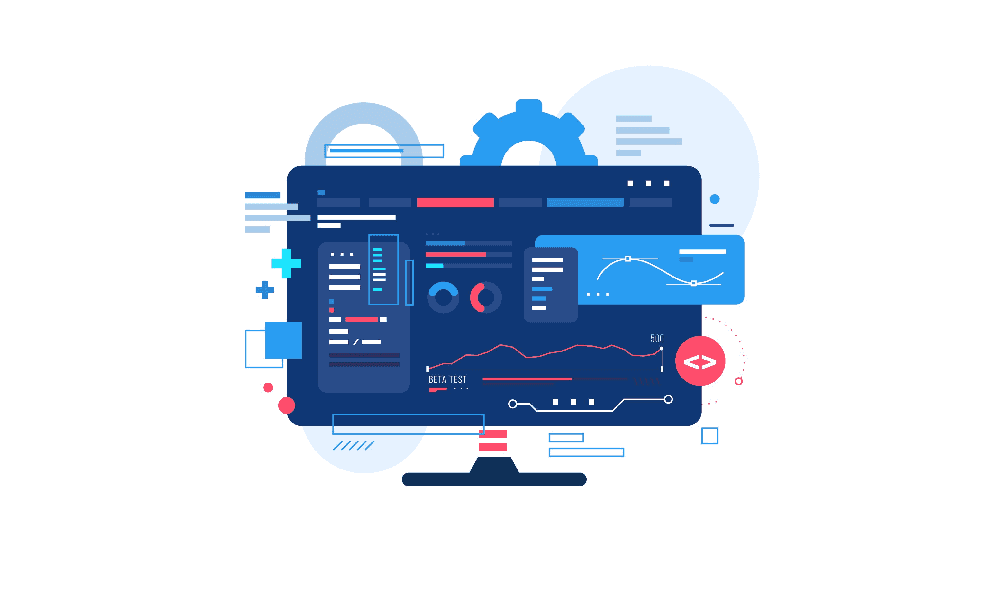The future growth of your organization needs to shape up to consider an international user base to serve global traffic. Let’s get it right—modernization won’t happen with the wave of a magic wand. It caters to larger applications, so you must consider large-scale web app development.
Having a grounded view of large-scale web application development is crucial to the success of your modernization efforts. Tag along as this post explores the challenges and solutions in large-scale web application development, benefits, essential steps when developing the app, and more. Let’s dive in!
What is a Large Scale Web Application?
People have different views and notions of what a large-scale web application is. Let’s start with understanding the term. You may have a few dots in the picture if you are visualizing huge data centers, user bases, and vast server rooms. However, there’s more to it!
A large-scale web application can effortlessly handle an ever-growing user base, excessive loads, and an increasing data pool. A system that can’t handle the weight will result in terrible business consequences.
So, what are the characteristics of a large-scale web application? Here are some insights!
- It can handle millions of users (requests for transactions), which are ever-increasing.
- The data management is accurate, involving intelligent structuring, indexing, data security, etc.
- The scalability is both at the web server level and the database level.
- A large-scale web application needs to have a proper distribution strategy, which involves the ability to operate across multiple systems and geographical locations.
- Large-scale applications are typically distributed, with the app running on servers geographically closer to the user (using CDNs). Plus, one can consider having apps run in the cloud.
- The large-scale apps are available 24/7.
- Lastly, the accessibility to the web app should be seamless, augmenting the user experience.
One must carefully consider such factors during the development process, which are critical for success when building the app.
Benefits of Building a Scalable Web Application
Let’s take a moment to think—users trying to access your web app will look for super-fast loading time. Plus, they will want 24/7 availability and seamless access, irrespective of how many people are trying to access your web app. Thus, it is a huge responsibility to design the app correctly so that the challenges are streamlined and the UX is excellent.
If the web app is developed well, you will find users vying for your app; the downside is users abandoning your app for want of a great user experience. Why do you need to be concerned? It’s simple—the benefits of a scalable web app are immense, and here’s a peek.

Augmented User Experience (UX)
Let’s start with UX. A scalable web app spells a boost in performance. Thus, if your user base or data volume grows, the app will seamlessly handle the volumes. What’s more:
- load times will remain consistent
- functionalities will perform seamlessly
- and the UX will maintain responsiveness
All the factors will help to improve user experience, resulting in happier customers and increased loyalty.
Seamless integration of new features
As a business owner, you’d want to build an app that supports plugging in new features or diverse facets of functionality. A scalable app allows smooth integration of new services and features, spelling value for money.
Supports sustainability
With ever-growing consumer needs and extreme changes in technology and market conditions, a scalable web app helps to adapt to future changes. Thus, a forward-thinking approach ensures that your app remains competitive and relevant even if there are dramatic changes in the future.
High security
A scalable web app has clearly defined boundaries, which gives you extra security from cyber-attacks. A scalable web architecture also helps you restrict data loss or block access to certain services.
Cost efficiency
A great advantage of a scalable web app is that there is no need for a complete overhaul. Therefore, when one needs to add resources incrementally, it is easy to expand without extra costs. It helps to save costs and time, as the redevelopment of the app from scratch isn’t necessary.
Reduced development time
In a scalable app, developers can structure the code into small modules. Thus, any change is seamless, reducing development time. Moreover, it’s easier to integrate new features and services. One does not need to modify the overall structure, which is an optimal scenario for both business owners and developers.
Business continuity
With dramatic changes in the market or technology, a scalable web app can handle increased loads. What’s more: one can shift the operations to different servers. The resilience is evident, which impacts users minimally and helps to maintain business continuity.
Market Edge
Future-ready organizations are committed to offering unmatched customer satisfaction. Developing a scalable web app is a step towards commitment, demonstrating foresight. Plus, it helps to give that extra competitive edge and positions the business favorably.
Bottom line: The benefits of developing a scalable web application are not a strategic choice. It is a step towards future-proofing your business, offering resilience, and ensuring cost efficiency. Eventually, it is the ultimate game-changer for your business.
Challenges and Solutions in Large-scale Web Application Development
Developing any application will have unique challenges, and building a large-scale web application is no different. It’s a huge opportunity to transform hurdles into seamless advancements. Let’s look at key challenges and their respective solutions.
Dealing with large volume traffic and distributing via load balancing
- Challenge: High traffic leads to the need for scaling! It is a primary challenge because, if not managed well, it can lead to performance issues and reduced UX. Plus, it also strains the servers.
- Solution: It is recommended to try load balancing, which prevents server overload. Plus, it maintains a healthy amount of activity on each server, distributing network traffic. A load balancer helps to create a highly scalable, available, and reliable web application for your users. Plus, it helps to optimize the servers’ capacity and improves the application’s performance.
Furthermore, what may help to manage surges of traffic volumes without impacting your infrastructure is to adopt auto-scaling practices. Plus, you must consider leveraging cloud services too.
Dealing with complexities and dependencies
- Challenge: Let’s consider you are in the process of expanding the large-scale web application. At this point, one can expect complexity due to the web of dependencies between the various components. The complexity most often can impact facets such as the development speed, leading to difficulty in debugging and shooting up maintenance costs.
- Solution: One of the first things is to consider adopting an architecture that helps break down the application into smaller, independent services. Plus, developers can also consider implementing a microservices architecture that can help to effectively manage the complexity, which helps to streamline the development process. Another aspect is to employ automated testing and continuous integration/continuous deployment (CI/CD) practices, which can help to deal with the complexities and augment code quality.

Striking a balance between functionality and simplicity
- Challenge: Picture adding multiple features as the application grows. Yes, you’re right! There are times the additions can clutter the UI and degrade the UX.
- Solution: When developing a large-scale web app, you must proactively work on the vision, strategy, and resilience. One will also need to ensure that the app grows in scale and maps up to reliability, strength, and user satisfaction standards.
Working on scalability and boosting performance
- Challenge: The scaling of the app must not impact the performance. Often, as the user base expands, it gets challenging to maintain responsiveness.
- Solution: It is pertinent to consider adopting performance optimization strategies. What are the strategies? You must consider including caching and employing Content Delivery Networks (CDNs). Plus, consider using a scalable database and stateless design, which can handle the scaling of the app while boosting its performance.
Regulating legacy codebase and systems
- Challenge: One of the reasons that an application experiences restricted evolution is outdated systems and sprawling legacy code.
- Solution: To overcome this challenge, consider adopting or switching to emerging technologies. You may also consider gradual refactoring of the legacy codebase. Furthermore, developers often prefer adopting a strangler pattern where new functionalities are developed using emerging technologies, replacing the legacy systems gradually.
Building Scalable Applications: Essential Steps and Considerations
A prerequisite to building a scalable web app is a futuristic vision. With a robust understanding of the application’s needs and potential, developing a web app primed for scalability is easy.
1. Assess the current and future needs to manage expectations
Try and start with evaluating the present capacity of your web app. Check:
- The users it can accommodate.
- The data it can process.
After providing the baseline, consider deducing the metrics based on expected growth over a period. The insights help to further your strategic planning.
2. Use metrics to establish scalability
Let’s consider that the insights suggest scaling. It is pertinent to check the scalability issues that need focus. Here are four scalability metrics that can come in handy.
Table 1: Metrics to establish scalability
| Memory utilization |
CPU usage |
Network Input/Output |
Disk Input/Output |
|---|---|---|---|
| The amount of RAM a specific system uses at a certain unit of time. |
High CPU usage is indicative of performance issues. Consider app-monitoring tools to measure usage. |
The time you invested when sending data from one process that’s tracked to another. |
Includes all the operations occurring on a physical disk. |
3. Select tools that help monitor application scalability
Once the metrics to focus on are in place, consider using app-monitoring tools to track the related metrics. Some good application monitoring solutions (APM), such as Prominent PaaS (like Heroku) and IaaS (like AWS), make the task easier. Further, Elastic Beanstalk (AWS) works on an inbuilt monitoring system, while Heroku has a New Relic add-on that facilitates monitoring.
4. Choose the right software architecture pattern for scalability
It is critical to spend time, research, and then pick the most relevant software architecture as it is one of the most important parts of application scalability. There are two main architecture patterns, i.e., Monolithic Architecture and Microservices Architecture.
A Monolithic app is built in one large system and usually one codebase. On the other hand, Microservices is built as a suite of small services, each having its codebase.
5. Select the right technology stack
The selection of the technology stack is significant as it can impact scalability. Typically, technologies that are known for their scalability are a great choice, such as React.js or Vue.js for the front end and Node.js for the backend.
The type of database will depend on the data types that you plan to store. Thus, consider MySQL or PostgreSQL for relational data, whereas NoSQL databases like MongoDB, are a good choice for unstructured data.
6. Select the right framework for scalability

Yet another important facet to boosting the performance of an app is selecting the right frameworks which support the increase of features. The selection will depend on the usage of the development language. For example, one can choose frameworks like Django and Ruby on Rails for developing scalable web apps.
There are other frameworks, such as React.js, Angular.js, Laravel, etc. One must remember to check the choice of the infrastructure and architecture pattern for the success of the application scalability.
7. Plan for performance optimization
When considering scalability, one must also look at maintaining high performance. Thus, it is important to look at strategies such as caching, load balancing, and adopting CDNs to ensure that the web app is responsive even under high-load scenarios.
8. Prioritize security
It is critical to consider embedding security facets when developing your scalable web app. With increased breach risks, developers often prefer to employ robust authentication, authorization, and encryption, which helps to find and abate vulnerabilities.
Wrapping Up
As a forward-thinking business leader who chooses to future-proof your organization, large-scale web app development must be an option. Consumers’ demands are ever-increasing, and building a high-quality app that meets these changing needs is pertinent.
Scalability is at the core of growing your business, and it can help your business meet all the future goals to touch new horizons of growth. The time is ripe to build scalable web apps and make a winning investment.
Develop Large-Scale Web Applications With Imaginovation
Do you want to build a game-changing large-scale web application for your business? If you are looking forward to developing futuristic scalable apps, don’t hesitate to talk to us.
We are an award-winning web and mobile app development company in Raleigh with ample experience, and we can help you build robust web apps and best-in-class solutions.
Let's Talk.
Ready to build an app, but not sure where to start?
We've got you covered. Click the button below to get started.





